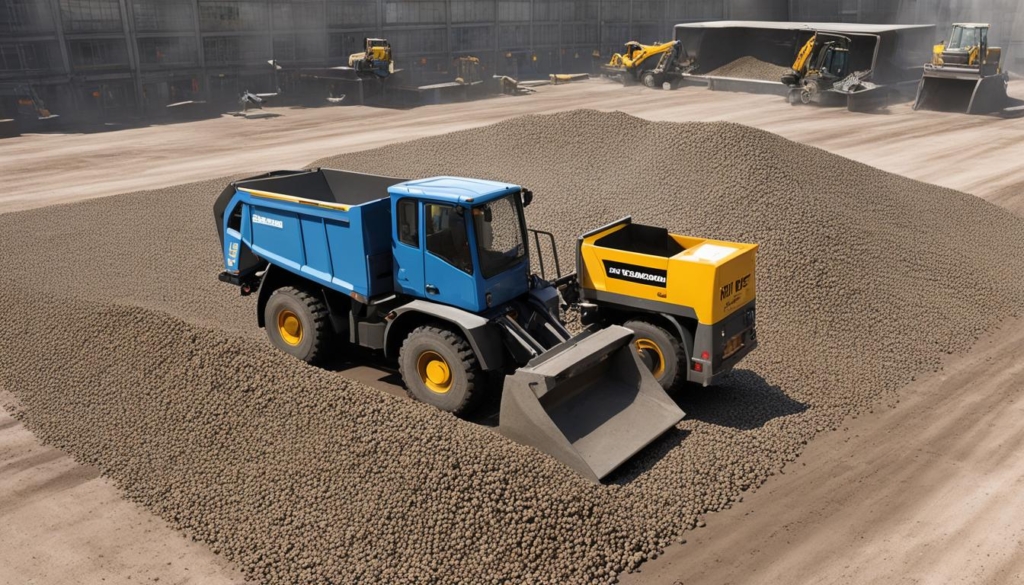Are you curious about the term “WMM” that you often come across in road construction? WMM stands for Wet Mix Macadam, which is a crucial method used to create a strong and durable base layer for roads. In this article, we will explore the full form of WMM in road construction and uncover its meaning and significance.
Key Takeaways:
- WMM stands for Wet Mix Macadam, a road construction technique.
- WMM involves mixing graded aggregate and granular material with water to form a dense mass.
- It provides a stable and well-drained foundation for road surfaces.
- Specific equipment and machinery are required for WMM construction.
- Field tests and quality control measures ensure the durability and quality of the WMM layer.
Equipment and Machinery for WMM
To carry out Wet Mix Macadam (WMM) work, a range of specialized equipment and machinery is essential. These include the following:
WMM Plant
The WMM plant is a vital component in the WMM construction process. It is responsible for efficiently mixing the aggregates and binding materials to create a consistent and well-prepared WMM mix. The plant ensures the proper blending and uniform distribution of materials, resulting in a high-quality WMM layer.
Loader
A loader is an essential machine used in WMM construction. Its primary function is to load the WMM material onto tipper/dumpers for transportation. The loader plays a crucial role in the efficient handling and transfer of the materials, ensuring a smooth workflow and timely completion of the project.
WMM Paver (Sensor)
The WMM paver, equipped with advanced sensor technology, is responsible for accurately spreading the WMM material onto the prepared surface. The sensor system ensures an even distribution of the mix, maintaining the specified thickness and slope. The paver guarantees precision and consistency during the WMM construction process.
Motor Grader
A motor grader is an essential piece of equipment used in WMM construction for achieving the desired slope and grade. It assists in the accurate leveling and shaping of the WMM layer, ensuring a smooth and well-aligned surface. The motor grader plays a crucial role in creating a uniform and stable WMM base for the road.
Vibratory Rollers
Vibratory rollers are extensively used for compacting the WMM layer. These rollers exert dynamic forces on the WMM material, ensuring its proper compaction and densification. The vibrations generated by the roller help to eliminate air voids and achieve the desired level of compaction, resulting in a strong and durable WMM layer.
Tipper/Dumpers
Tipper/dumpers are essential vehicles used for the transportation of WMM materials from the mixing plant to the construction site. These vehicles are designed to carry bulk loads, ensuring the timely delivery of the required materials. Tipper/dumpers play a critical role in maintaining the workflow and efficiency of the WMM construction process.
Plate Compactor
A plate compactor is used for compacting specific areas of the WMM layer that cannot be effectively reached by larger compaction equipment. This compact, handheld machine helps to achieve improved compaction in tight spaces, ensuring the overall integrity and stability of the WMM layer.
These equipment and machinery work together in harmony to execute the WMM construction process efficiently and effectively, resulting in a durable and long-lasting road surface.
Material for Wet Mix Macadam
The coarse aggregate used for Wet Mix Macadam (WMM) is an essential component in road construction. It should be sourced from a recognized quarry and meet specific physical requirements and strength as per the technical specifications. To ensure compliance, the aggregate must meet the requirements outlined in Table 400-10 of the Ministry of Road Transport and Highways (MORTH) and Technical Specifications.
The physical characteristics of the coarse aggregate play a crucial role in determining its suitability for WMM. Some key properties include the Los Angeles Abrasion Value, Aggregate Impact Value, and Combined Flakiness and Elongation indices. These characteristics help evaluate the durability, strength, and shape of the aggregate, ensuring it can withstand the demands of the road construction process.
“The quality of the coarse aggregate is paramount in ensuring the long-lasting performance of the Wet Mix Macadam.”
Additionally, the water absorption of the coarse aggregate should not exceed 2.0%. If it exceeds this limit, a soundness test should be conducted to assess its stability and resistance to change under wetting and drying conditions. This test helps identify any potential durability issues that may affect the overall performance of the WMM.
Furthermore, the mix of crushed stone and aggregates should be proportioned accurately to achieve the specified grading. The proper grading of the mixture ensures the optimal distribution of particle sizes, resulting in a well-compacted and stable WMM layer.
The following image illustrates the importance of using high-quality coarse aggregate in Wet Mix Macadam construction:

By using coarse aggregate that meets the necessary standards and following the recommended mix design, the Wet Mix Macadam can deliver a robust and durable road surface, capable of withstanding heavy traffic loads and adverse weather conditions.
Preparation of WMM Mix
The successful construction of Wet Mix Macadam (WMM) relies on the precise preparation of the mix. This involves determining the individual gradation of the ingredients and blending them to achieve the specified grading.
The mix design, proportioning of all materials, and the grading/test reports must be carefully calculated and compiled. It is crucial to submit this information to the engineer for approval. This ensures that the mix meets the required standards and specifications.
“Proper mix design and proportioning are key factors in achieving a durable and high-quality Wet Mix Macadam.”
Prior to commencing the actual WMM work, a trial patch of appropriate length is constructed. The purpose of this trial patch is to verify that the mix meets the specified requirements. The patch is laid on an approved granular sub-base layer and subjected to testing. If the results do not meet the requirements, the process is repeated until the desired outcome is achieved.
It is important to note that any changes in the gradation during the course of work should be approved by the engineer. This ensures that the mix remains consistent and maintains its desired properties throughout the construction process.
Proper mix design and proportioning are crucial to the success of Wet Mix Macadam construction, as they ensure the structural integrity and longevity of the road.
Importance of Mix Design and Proportioning
Mix design is a critical aspect of Wet Mix Macadam construction. It determines the composition and proportions of the various materials used in the mix, ensuring the desired performance and characteristics. Proper mix design takes into account factors such as traffic volume, climate conditions, and the desired strength and durability of the road.
Proportioning involves determining the correct ratio of aggregates, binder, and water to achieve the desired gradation and properties of the WMM mix. This ensures that the mix has optimal workability, stability, and compactability during construction.
By employing an appropriate mix design and proportioning, road construction professionals can create a robust and long-lasting Wet Mix Macadam layer that withstands the demands of heavy traffic and adverse weather conditions.
Wet Mix Macadam Construction Operations
The construction of Wet Mix Macadam involves several operations. To ensure a strong foundation, the surface that will receive the WMM layer needs to be prepared according to the specified lines and cross-fall (camber). It is crucial to make the surface free of dust and other extraneous material to ensure proper adhesion and compaction of the WMM layer.
Lateral confinement of the WMM layer is achieved by laying materials in adjacent shoulders. This helps to stabilize the layer and prevent any lateral movement or displacement during construction and over time.
The WMM layer is laid and compacted in two uniform layers. The first layer is spread by a motor grader, which ensures an even distribution of the material. The second layer is spread using a sensor paver, which helps maintain the desired thickness and slope of the layer.
The WMM material is thoroughly mixed in a dedicated WMM mixing plant, ensuring proper blending of aggregates and binding materials for a homogenous mix. Once the mix is ready, it is loaded onto dumpers for transportation to the WMM location.
Transportation, Spreading, Compaction, and Finishing
Once the Wet Mix Macadam (WMM) material has been transported to the construction location, the next steps involve spreading, compaction, and finishing.
The spreading of the WMM material is carried out with precision to ensure uniform coverage. One of the essential tools for achieving proper compaction is the vibratory compactor. This equipment helps in compacting the WMM layers effectively, ensuring stability and durability.
During the compaction process, a specific pattern is followed to achieve the desired compaction levels. Through full-scale trials conducted on-site, the number of passes required for compaction is determined. These trials help in achieving the specified maximum dry density (MDD) as per the Indian Standard IS: 2720 (Part-8).
The compaction process starts from the lower edge and gradually moves to the upper edge, width by width. This systematic approach ensures that each part of the WMM layer receives adequate compaction, resulting in a solid foundation for the road.
After the final compaction, the WMM surface is allowed to dry for a minimum of 24 hours. This drying period is crucial as it allows the material to settle properly, enhancing its strength and stability.
Finishing is an important aspect of WMM construction. The finished WMM surface should have a suitable cross fall to ensure efficient surface drainage, preventing the accumulation of water. Additionally, the level of the finished surface should be within the specified tolerance limits, ensuring a smooth and even road surface.
The transportation, spreading, compaction, and finishing stages are vital in creating a robust and well-constructed Wet Mix Macadam layer. By following proper procedures and adhering to the specified guidelines, WMM can provide a durable and long-lasting foundation for road infrastructure.
Wet Mix Macadam Field Test
During the construction of Wet Mix Macadam (WMM), field tests are crucial to ensure the quality of the work. One of these tests is the field density test by sand replacement. This test helps determine the compaction achieved in the WMM layer, ensuring its stability and durability.
Quality control tests should be carried out prior to the commencement of the next WMM layer. These tests, including the field density test, help maintain the desired quality and specifications throughout the construction process.
The finished WMM should meet the requirements specified in the Ministry of Road Transport and Highways (MORTH) Technical Specification and Contract. By conducting field tests and adhering to quality control protocols, the construction team can ensure that the WMM meets the specified standards, guaranteeing a sturdy road base.
It is important to note that vehicular traffic or heavy movement should not be allowed on the finished WMM surface until it has dried and the wearing course is laid. This precautionary measure protects the WMM layer from damage and allows it to settle and establish a strong foundation for the road surface.

Conclusion
Wet Mix Macadam (WMM) is an essential component of road construction, providing a strong and durable base layer that ensures the longevity and stability of the road. By mixing clean, crushed, graded aggregate and granular material with water, WMM forms a dense mass that can withstand heavy traffic loads and adverse weather conditions.
To achieve successful WMM road construction, it is crucial to use the right equipment and machinery, such as a WMM plant, loader, WMM paver, motor grader, vibratory rollers, tipper/dumpers, and plate compactor. These tools help in the proper transportation, spreading, compaction, and finishing of the WMM material, resulting in a well-drained and reliable road surface.
Attention to detail is also essential during the WMM process. Careful preparation of the base and precise control of the mix design contribute to the overall quality and performance of the finished road. Field tests and rigorous quality control measures ensure that the WMM meets the specified requirements, guaranteeing the safety and durability of the road for years to come.
In conclusion, WMM is a vital element in road construction, providing a solid foundation for smooth and safe vehicle movement. By following the proper WMM process and employing the necessary equipment and quality control measures, road builders can create roads that withstand heavy traffic, withstand environmental factors, and stand the test of time.
FAQ
What does WMM stand for in road construction?
WMM stands for Wet Mix Macadam, which is a road construction method that involves mixing clean, crushed, graded aggregate and granular material with water to form a dense mass.
What equipment and machinery are required for WMM?
The equipment and machinery required for WMM include a WMM plant, loader, WMM paver (sensor), motor grader, vibratory rollers, tipper/dumpers, and plate compactor.
What is the material used for Wet Mix Macadam?
The coarse aggregate used for Wet Mix Macadam should be crushed stone from an identified quarry that meets specific physical requirements and strength as per technical specifications.
How is the WMM mix prepared?
The preparation of the WMM mix involves determining the individual gradation of the ingredients and blending them to achieve the specified grading. The mix design and proportion of materials need to be approved by the engineer.
What are the construction operations involved in Wet Mix Macadam?
The construction of WMM involves preparing the surface, laying and compacting the WMM in two layers, and achieving the specified cross fall. Lateral confinement is achieved by laying materials in adjacent shoulders.
How is the WMM material transported, spread, and compacted?
The WMM material is transported to the location, spread evenly with a motor grader and a sensor paver, and then compacted with a vibratory compactor. The compaction process starts from the lower edge and moves to the upper edge.
What field tests are carried out during WMM construction?
Field tests, such as the field density test by sand replacement, are carried out to determine the compaction achieved. Quality control tests should be conducted prior to the commencement of the next WMM layer.
What is the role of WMM in road construction?
WMM provides a strong and durable base layer for road construction. It creates a stable and well-drained surface that supports the smooth and safe movement of vehicles.




Pingback: WBM Full Form in Road Construction: Decoding the Abbreviation - Dream House Listing | List your Property For Free
Pingback: Unveiling "BBM" in Construction: Two Common Meanings - Dream House Listing | List your Property For Free
Pingback: "CFO" Full Form in Construction: Two Key Meanings - Dream House Listing | List your Property For Free